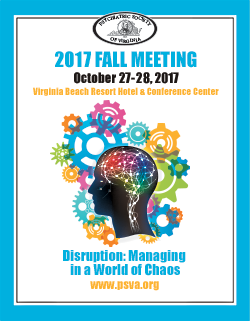Summer 2017 Issue |
|
What is the APA Assembly?
John P. D. Shemo, MD, DLFAPA
PSV Representative to the
APA Assembly
The Assembly is composed of elected representatives of the 86 district branches and state associations which geographically represent the 37,000 members of the APA. We are, incidentally, the third largest specialty group in the AMA. It is a deliberative body which recommends actions to the Board of Trustees. “To ensure diversity of thought and ideas,” in addition to the geographically elected members, there are also Assembly representatives selected to represent various constituencies of members that may feel under-represented. Thus, there are Assembly representatives who specifically represent groups such as Hispanic members, African-American members, LGBT members, women members, etc., as well as members who represent areas of sub-speciality interests such as forensic psychiatry, child and adolescent psychiatry, administrative psychiatry, public psychiatry, etc. The Assembly is therefore a very diverse group.
Additionally, administratively, the Assembly is divided into seven area councils which have meetings in preparation for the full Assembly meetings. These are mostly geographical, with the addition of various components of the committee on minority and under-represented groups, the resident and fellow members group, the early career psychiatry group and the allied organization liaisons. The areas are largely based on the geographical distribution of psychiatrists at the time of the organization of the APA Assembly, almost 50 years ago. Thus, region two is just New York State and region seven is just California. Of these, area five is geographically the largest region in the APA – extending from Virginia and West Virginia to the north, Florida and Puerto Rico to the south, and Oklahoma and Texas to the west. There were few psychiatrists in this area from 50 years ago when the APA Assembly was founded. Now, area five is so populated by psychiatrists that a unanimous vote by area five representatives and any other one of the seven areas, would pass any “vote by strength.”
An Assembly function is to approve actions of various executive components of the APA such as approving the actions of various councils. The Assembly’s major function is, however, the presentation of “action papers,” in which they recommend actions to the Board of Trustees. These action papers must be passed by the majority vocal vote of the Assembly, which may include representatives with “hundreds of votes” or those with only one vote. I will note in this regard that Assembly members with only one “vote” represent minority or sub-specialty members who are also represented by their district branch representatives. If the vote is clear and overwhelming, this is what prevails. If not, from the floor, Assembly members can call for a standing vote. If it is still close, there can be a call for a vote by strength. In this, Assembly representatives must, by written ballot, clarify how many APA members they represent and how they stand on the issue. Given the time involved in doing this, and the fact that the requirement of “vote by strength” requires an immediate collaboration of at least 11 district branches in at least three areas, this action of “vote by strength” occurs at most two or three times during a given meeting.
While I understand that this is all rather complex, it does usually work reasonably well. My personal bias is that the APA would be best served by movement towards the AMA model of having the leadership evolve from within service in the Assembly, in contrast to the current APA model where the leadership tends to be elected by ”name recognition” of individuals who often have not had prior experience with the functioning of the organization. This concern is not, however, relevant to Anita Everett, who has served in the Assembly as a representative of the PSV and in other Assembly roles.
To paraphrase Mark Twain, “I wish I could have written a shorter letter, but I did not have time to do so.” I am always available to go into further detail with our members in regard to how the organization responds to their concerns, as is Adam Kaul, MD, DFAPA and Varun Choudhary, MD, DFAPA.
YOUR NEWSLETTER IS NOW AVAILABLE ON YOUR SMARTPHONE AND TABLET!
JOIN PSV TODAY!
REGISTER TODAY!
PSV 2017
FALL MEETING
October 27-28, 2017
Virginia Beach Resort Hotel
& Conference Center
Virginia Beach, Virginia
MARK YOUR CALENDAR!
APA Find a Psychiatrist
Are you accepting new patients?
Opt into APA’s “Find A Psychiatrist” database. To view the functionality or opt-in, CLICK HERE
FYI: A link for this option has been added to the PSV website so the public can find you when they are looking for help.






